Kent’s Pride
For those of us who are keen followers of the RHS Chelsea Flower Show, whether it is visiting in person or soaking it up through the television coverage, one iris that features regularly either in the gardens or on the trade stands, is ‘Kent Pride’. This iris is a delightful confection of copper brown, the falls are veined and splashed with yellow and it is a very striking flower. It was bred by Philip Hutchison in 1958 and has one of Cedric Morris’s irises, ‘Benton Susan’, as a parent.
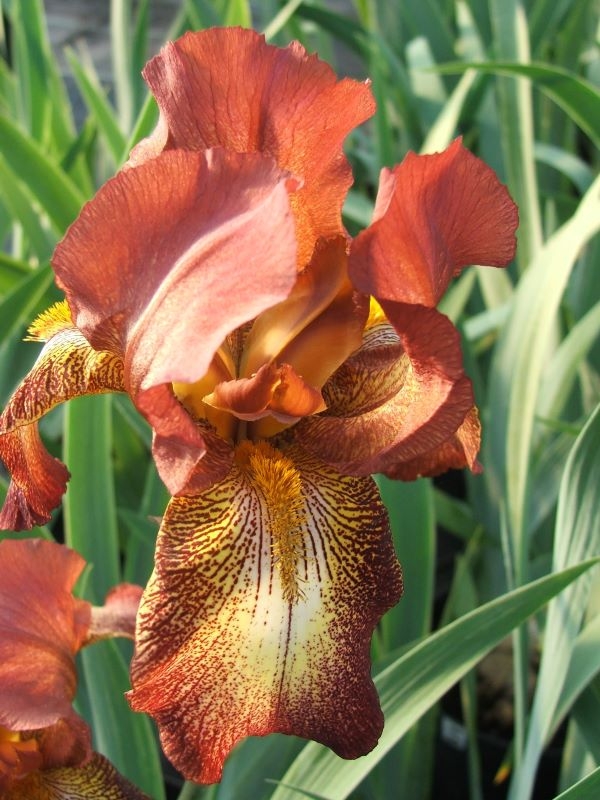
Tall bearded iris ‘Kent Pride’
But it was not for ‘Kent Pride’ that Kent iris hybridiser, Philip Hutchison gained his highest accolade. No that was for ‘Dancer’s Veil’.
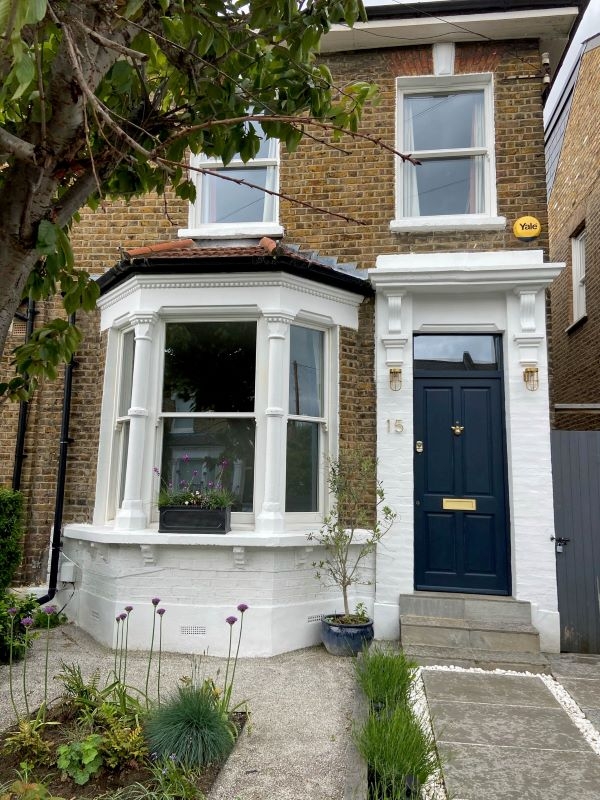
Lacon Road, East Dulwich – May 2021
Philip was born 24 May 1910 at a house in Lacon Road, East Dulwich. He was the youngest son of Thomas Hutchison (1872-1944) and Rosa Elizabeth Howland (1869-1960). Thomas was a Professional photographer, some of his work appeared in a guide to Orpington village. Thomas himself was born at Scotney Lodge Cottage, his father Henry was a gardener and domestic servant at Scotney Castle in Lamberhurst in Kent, so horticultural was certainly in the genes.
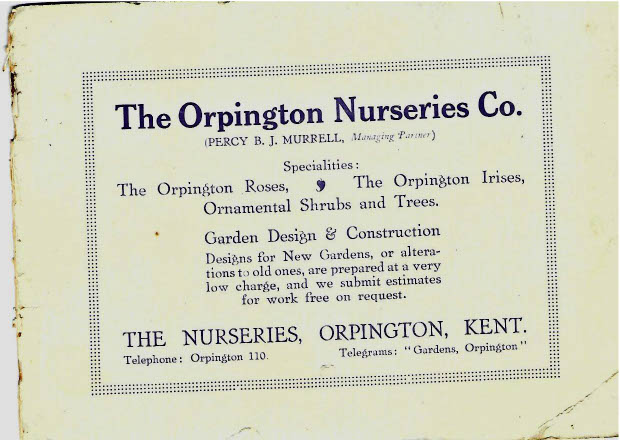
On leaving school, Philip started working for Mrs Olive Murrell at the well-known Orpington Nurseries (more of these in another post). During World War II, Philip saw active service as a gunner (1096408) in the Royal Field Artillery Battery in Italy. He was convalescing at Epperstone Hall Military Hospital in Nottinghamshire when he met Edna Webster. They married on 20 June 1942 at North Collingham in Nottinghamshire. The Hutchison family subsequently returned to Kent at the end of hostilities in order for Philip to return to full time employment at the Orpington Nurseries. There is no doubt that his knowledge and skills were greatly admired by Mrs Murrell. He became her right hand man and foreman at the nursery and worked very closely with her until her death on 18th August 1957.
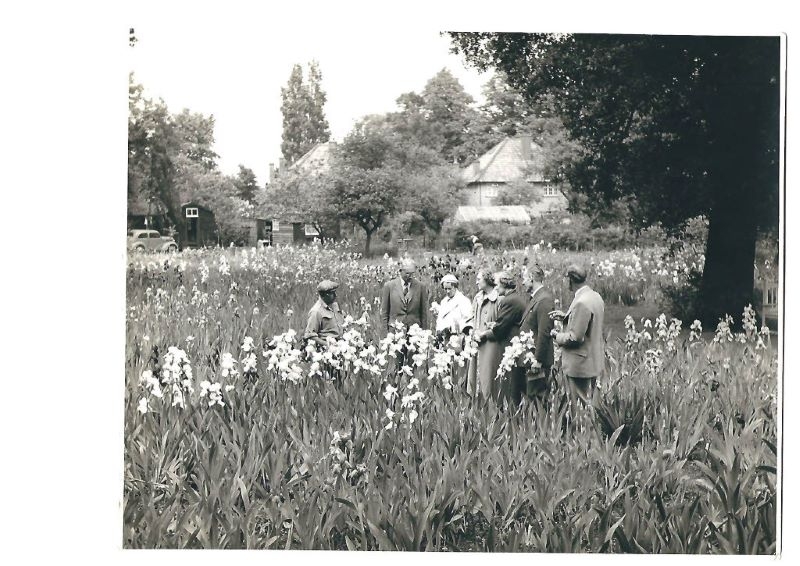
Philip Hutchison is on the left in the picture above.
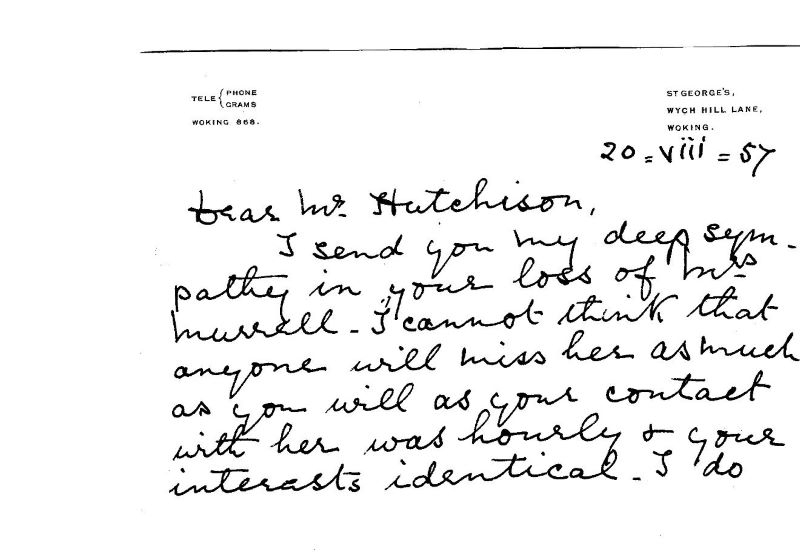
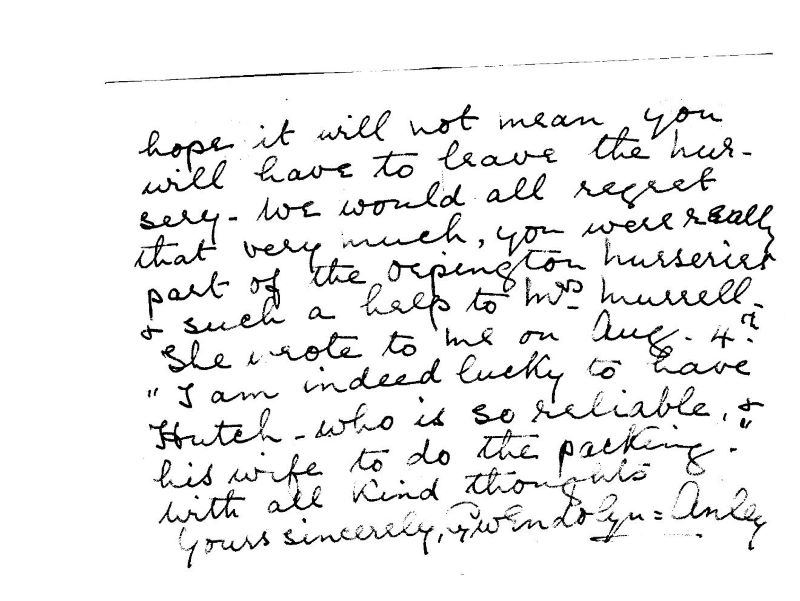
Letter of condolence from Gwendolyn Anley, a fellow irisarian, received by Philip Hutchison following the death of Olive Murrell.
It was whilst he was at the Orpington Nurseries in 1952 that he started to breed irises, having watched and learned a lot from Mrs Murrell. He first began to be noticed in iris circles in 1956 when a seedling, later registered as ‘Freshwater’, received a Highly Commended at the British Iris Society Show. This was the first of many of his varieties to be introduced by the Orpington Nurseries. The next year he named ‘Sunny Spain’ a brilliant near-variegata (definition of a variegata – yellow standards with red, maroon or brown falls) and the deep blue Iris sibirica ‘Ellesmere’, which had prominent red spathes on the stem. ‘Lavender Patch’, a small, neat iris of unusual pattern was also named. His love affair with plicatas (definition of a plicata – white to yellow ground cover, stitched, dotted, or veined in a different darker colour at the petal edge) began in 1958 with ‘Collingham’ and ‘Kent Pride’ (both red-on-yellow plicatas) and ‘Golden Forest’, the lovely gold-on-white plicata which, ten years later, was to win the Dykes Medal.
His most famous production was, of course, the lavender-blue-on white plicata ‘Dancer’s Veil’ (registered in 1959). He chose two American varieties as potential parent plants, they were ‘Rosy Veil’ and ‘Dancing Waters’. He did not breed directly from them …’I crossed ‘Rosy Veil’ with one of my own seedlings and the crossed the result with ‘Dancing Waters’. This gave me the seedling ‘Dancer’s Veil’ – for which I combined the names of the two parents’. ‘Dancer’s Veil’ was raised in 1957 and when it was first shown it received a highly commended award, was selected for trial at Wisley and took a RHS bronze medal.
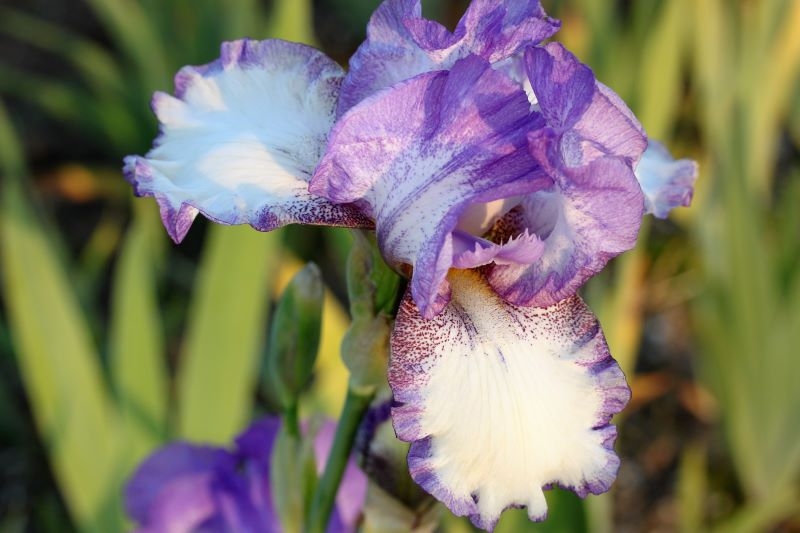
‘Dancer’s Veil’
‘Dancer’s Veil’ – white bloom with blanket stitch markings in lavender, fluted and ruffled with well-flared falls.
Following this success, it was submitted to the Florence Symposium in 1963. The Italian Iris Society had previously decided to organise a Symposium in order to develop greater interest in iris. The decision for it to be held in Florence made absolute sense because this city had been linked with the iris since the medieval period. This event was regarded as the equivalent of a “World Cup or Olympic Games” competition and to be successful you have to be the best.
The Florence event was held over a four day period and included visits to famous gardens and places of interest as well as the contest itself. It attracted world media interest and visitors/delegates from Europe and North America.
The judging of the competition was linked to various classes and awards. This is normal with iris competitions given the different forms of iris. Many people base their experience of judging to that reported at the Chelsea Flower Show. At this Show exhibitors are advised of their award by way of a sealed envelope on the first day of the Show. The Florence Symposium is different and takes the form of a final day celebration and public announcement of awards.
The Florence awards were held in the Palazzo Vecchio a very old and imposing building. The guests and delegates, including many VIPs were invited to the ceremony. The ceremony commenced with seven men dressed in medieval costume entering the hall carrying long silver trumpets. The Mayor of Florence then entered the hall and led his party to the awards table. The table contained the various awards and trophies AND a spike/stem of ‘DANCER’S VEIL’.
The ceremony started with a fanfare from the trumpeters before the Mayor of Florence and other dignitaries made the obligatory speeches before the awards were made. The premier award, the Golden Florin was to be given to ‘Dancer’s Veil’. The modern equivalent of BEST IN SHOW. This was a major success for Britain and the British Consul, Mr Chandos Harcourt, was delighted to receive the award on behalf of Philip Hutchison.
The Florence award was of major significance for British iris growers. The award was effectively a world title, given that all major iris growing nations were represented at the event. This included all the major North American growers.
In June 1963 the British Iris Society held a dinner to celebrate not only Philip Hutchison’s success, but also Mr H Castle Fletcher, a former president of the BIS, had gained fourth place in the same competition with ‘Gilston Garnet’, as well as the silver salver for best red iris. A spike of ‘Dancer’s Veil’ had place of honour at the top table and Philip received his award – the coveted golden Florence Florin – from Lady Wolfenden. ‘Dancer’s Veil’ was given the highest award by the British Iris Society, The Dykes Medal in 1963.
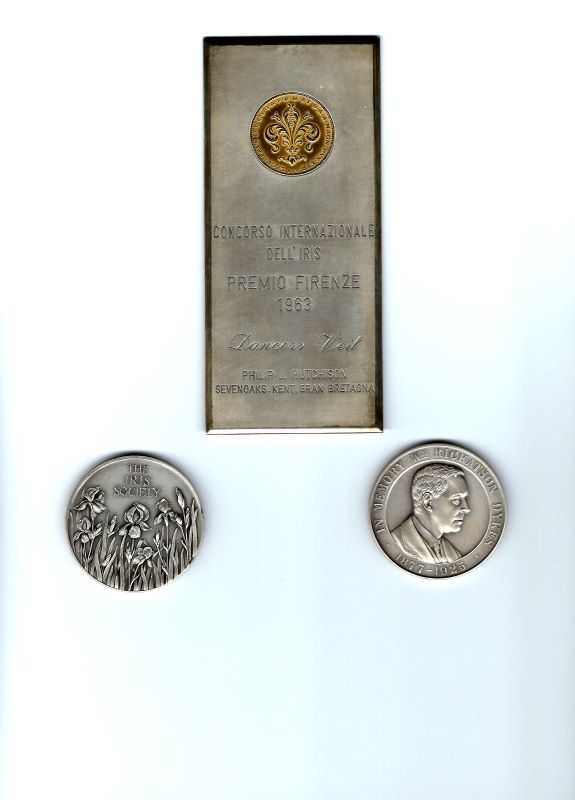
The Florence Award and the British Dykes Medal for ‘Dancer’s Veil’ 1963 and the British Dykes Medal for ‘Golden Forest’ 1969.
When the ‘Dancer’s Veil’ stock was large enough in 1963/64, Edna, Philip’s wife, had a stand in “Harrod’s” store in London taking orders from all over the world for ‘Dancer’s Veil’.
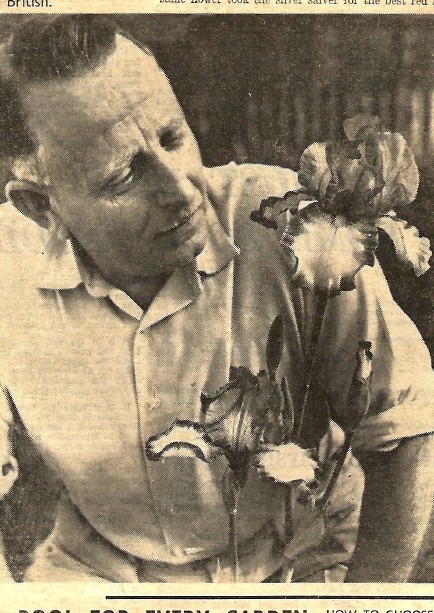
Philip Hutchison with his prize winning ‘Dancer’s Veil’
Philip left the nursery and was employed as a gardener at South Ash Manor near Wrotham, Kent continuing his iris hybridising in his own garden at 2 Ash Manor Cottages.
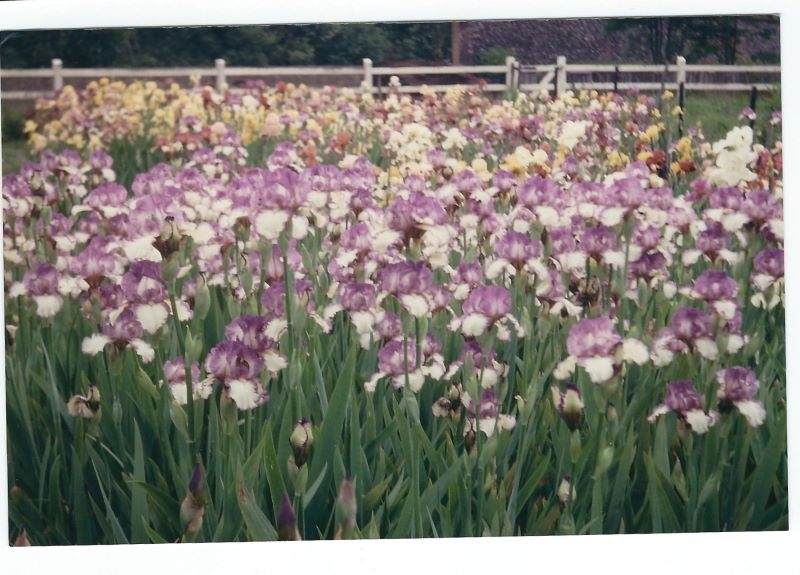
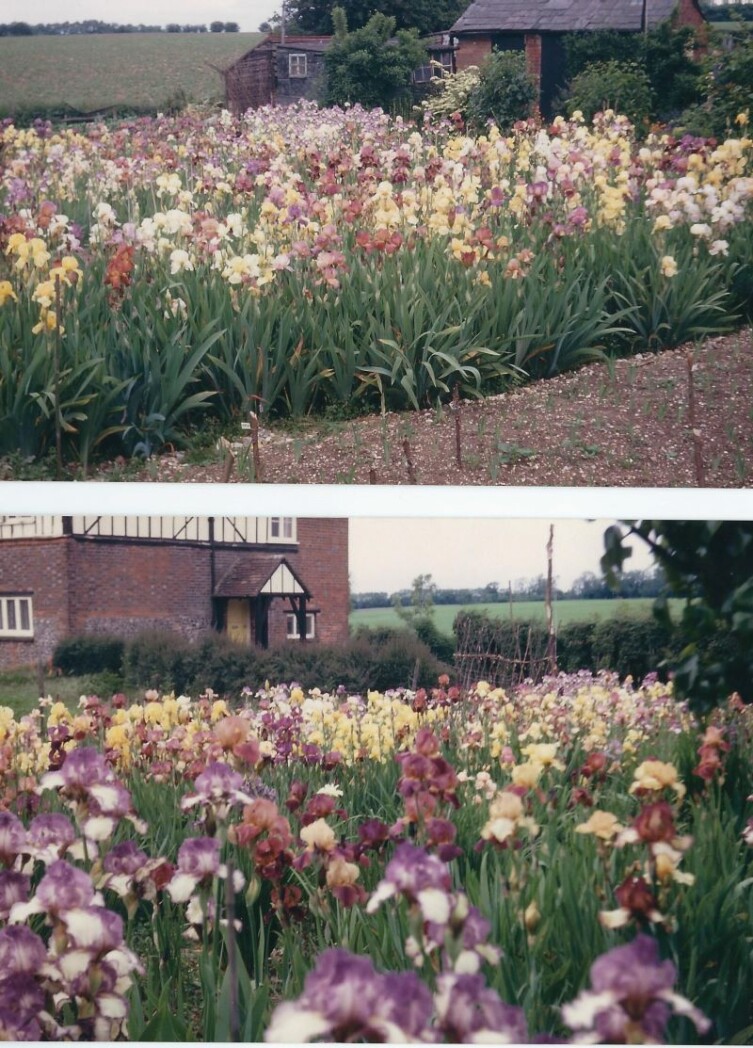
The iris beds at 2 Ash Manor Cottages
Iris introductions by Philip Hutchison
Siberian iris
‘Blue Mere’, ‘Ellesmere’ (RHS Award of Merit), ‘Nottingham Lace’, ‘Purple Cloak’, ‘Purple Mere’
Spuria
‘Ellison’, ‘Ticehurst’
Tall Bearded
‘Cherry Ripe’, ‘Collingham’, ‘Cookoo’s Cup’, ‘Dancers Veil’ (British Dykes Medal Winner 1963), ‘Freshwater’, ‘Golden Forest’ (British Dykes Medal Winner 1969 and same parent plants as ‘Kent Pride’), ‘Honey Light’, ‘Kent Pride’, ‘Lavender Patch’, ‘Lucid’, ‘Mauve Veil’, ‘Olive Murrell’, ‘Sunny Spain’(High Commendation Royal Horticultural Society 1957), ‘Transmere’
On his retirement Philip and Edna moved to Nottinghamshire to be near Edna’s family settling in Gunthorpe Village where they both made many friends in the village and passed on gardening tips to the locals. Philip died 13 April 1978 at Nottingham City Hospital. Edna died on 18 August 1997 at Caythorpe Nottinghamshire.
Extract from the obituary for Philip Hutchison in the British Iris Society Year Book 1978
‘Philip Hutchison was the epitome of the modest country gardener, rather short and thick-set and always to be seen with his pipe. Two memories of him linger with me, one of him talking earnestly about his seedlings at the old Orpington Nurseries, and the other of Philip and his wife at our annual dinners which they both so obviously enjoyed’. H R Jeffs
In conclusion Phillip Hutchison was a professional gardener. He did not come from a privileged background and his skills and knowledge were hard-earned. It is a modern habit, when considering the significance of a person’s contribution in their field of expertise to society to think of their legacy. In the case of Phillip Hutchinson his legacy, despite the passage of time, is exceptional. He developed, in addition to many other varieties, ‘Kent Pride’ and ‘Dancer’s Veil’. Both were recognised with awards of national and international importance. The legacy is that both iris, despite the advancement in the cultivation of iris in shape and form, are still of commercial importance. ‘Kent Pride’ is still used for show gardens at the RHS Chelsea Flower Show, the most prestigious flower show in the world. The name of Hutchison, in the world of iris, is still revered. There can be no greater compliment to his memory that thousands of gardens in this country and abroad include an iris of his creation in their gardens.
With grateful thanks to David Clifford, nephew of Philip Hutchison for the photos and all the information about his Uncle Philip.
